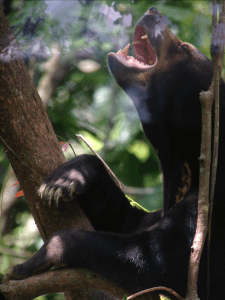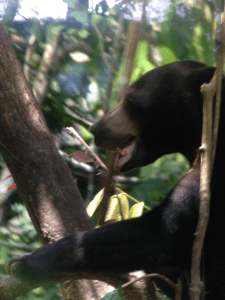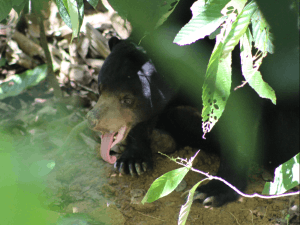“Look! Eyes in tree!” our guide pointed to the bank of the Kinabatangan River. All of us on the boat peered into the gloom, aiming our headlamps. Two large, orange ovals shone back at us. “What is it?” someone asked. “Sun bear,” the guide replied. I grinned in anticipation of observing more of these bears in our trip to a sun
bear conservation center the following day.

In the late morning of June 17 (day 5 of our Tropical Restoration Ecology course), the class visited the Borneo Sun Bear Conservation Centre in Sepilok, Sandakan. The Centre consists of a small enclosed entrance building to get tickets and chatchkas which led to an outdoor wooded area that serves as the bears’ habitat. An elevated, fenced-off walkway ran through the outdoor area from which tourists such as ourselves could observe the bears at a distance where neither humans nor bears would bother the other. Along the walkway were two observation platforms as well as several informational placards.

Native to Borneo, sun bears are the smallest type of bear on Earth. The black of their short fur is interrupted only by light brown on their muzzles and on two patches on their chests. They have dark, glinting eyes with a thin ring of light brown around the pupils. A sun bear’s two long fangs on the bottom jaw and long, curved claws help it pry apart pieces of wood in search of termites, which it then licks up with its long, pink tongue. In addition to termites, it eats honey and some fruit. The other behaviors I observed in the sun bears include trundling around while sniffing the ground, digging, and lazing about with their long, curved, pointy tongues hanging out. They frequented the ground under bushes and the junctions of tree branches.

As I learned from the placards, sun bears are critically endangered. People capture young bears as pets, then when they grow into threatening adults, they leave them confined in small cages and chains. They are also eaten in China as a delicacy. As they are legally endangered, efforts are being made to conserve the few left, via environmental education and habitat conservation. The bears in the Conservation Centre were rescued from suffering in captivity and being eaten in restaurants, and have a safe home in the wooded, spacious enclosure. When we were on the second viewing platform, we witnessed the bears being fed. Employees of the center tossed fruit over the fence and the sun bears sniffed it out, muzzles rummaging through the leafy floor.

As we were passing through the entrance building on our way back, we found a petition to increase enforcement of laws protecting the highly endangered Malaysian tiger and many people in our class signed it. In addition, Professor Coffman decided to adopt a sun bear on behalf of the class, which means that she paid some money to help sponsor the caretaking of one of the bears in the Centre and got a certificate. The bear we decided to adopt (the least popular one) was named Cerah, which is Malay for sunny. All in all, the trip to the Borneo Sun Bear Conservation Centre allowed us to observe these adorable animals more closely than is possible in the wild and to support wildlife conservation efforts.
Written by Flora Lucia Hayes, Environmental Science undergraduate.
